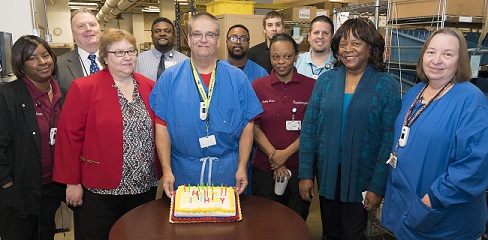A Colon Cancer Survivor’s Journey of Health and Hope

UM SJMC Supply Chain Specialist – Gary Neal- shares his survivor story
One fateful afternoon when I took my lunch break in the hospital cafeteria, I had no clue that it was going to be a lifesaving meal. As I ate my roast beef sandwich, I began choking. It was my lucky lunch break because my gastroenterologist Amin Khan, MD,came walking by and noticed I was having difficulty swallowing.
I'd been under Dr. Khan's care for years, in fact he did my first colonoscopy when I was 42, because I'm at high-risk for colon cancer. My mother had colon cancer. So, Dr. Khan said to me, 'It's time to come in for an upper endoscopy of your esophagus as well as a colonoscopy.' He realized I was overdue for that colonoscopy. I was supposed to come in at age 47 and was already almost two years late.
The endoscopy revealed that I had severe acid reflux, but the colonoscopy was something else. When I woke up after the colonoscopy and saw Dr. Khan standing by my side, I thought, 'Uh-oh, this is not good.'
The High-Risk Road of Missing Your Colonoscopy
My diagnosis was stage 1 cancer. I had a pancake polyp, which is the more difficult kind to detect. I needed a right hemicolectomy, which meant removing part of my colon and I also had vitamin infusions. Bottom line, when the doctor tells you to get a colonoscopy every five years because of your family history, you do that.
Fortunately, I'm right as rain now. This experience taught me to never take birthdays for granted. Until my cancer diagnosis, I was intensely focused on my career, but now I make sure to get home to my wife for dinner so we can spend more time together. These days, I'm taking more time to enjoy life. We love boating and fishing and do not hesitate to do it every chance we get.
I'm a living example of the excellence of the Cancer Institute. My care there was incredible. The staff from the Digestive Disease Center, the operating rooms, the infusion center- and more- are fantastic.
It usually takes seven to ten years for a normal polyp to turn into an adenoma – which is pre-cancerous – and then into cancer. If you have a history of polyps, we screen you every five years to stay ahead of this progression. If you have multiple adenomas, a polyp larger than 10 millimeters or are a smoker, we may advance to screening you every three years. It also depends if the polyp is flat or shaped like a mushroom (pedunculated). Flat polyps, like Gary's, are more likely to become cancerous, and polyps on the right side are usually more aggressive.
You have to be proactive and keep up with your screenings. Many patients procrastinate or forget. Anyone with a first-degree relative who has had colon cancer before age 60 should begin getting screened at age 40. Speak to your primary care provider to help determine the best screening schedule for you. People of normal risk can start screening at age 50.
